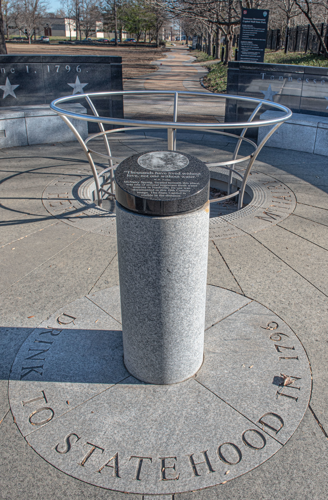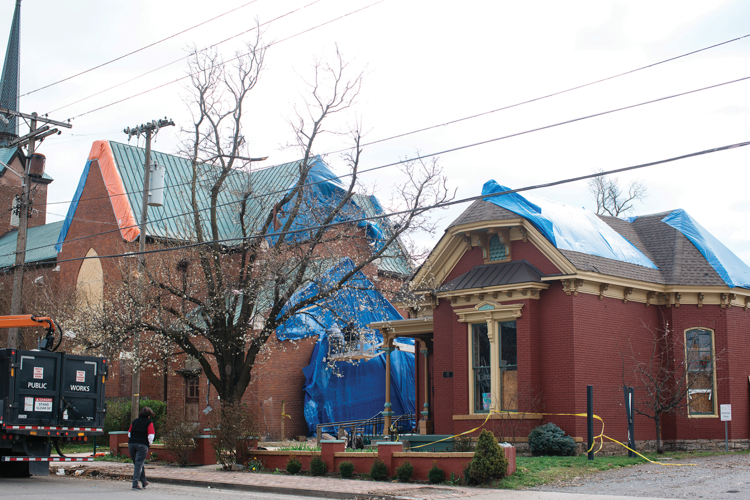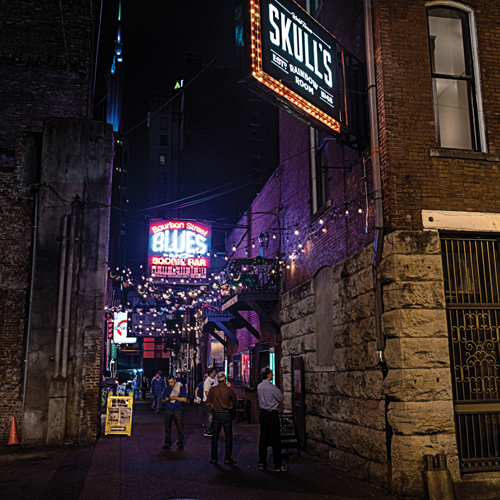Over a decade of being an “It” city, we’re all pretty tired of showing folks around. Parking is expensive, traffic is awful, and half the stuff you loved back in 2013 has closed to make way for a steakhouse or office space that no one wants to rent.
But if you do a little digging, there are still places you can take visitors to see where Nashville came from. Bonus: You can easily walk the roughly two miles these spots span, starting in Germantown and ending at Printers Alley.

Church of the Assumption on March 5, 2020, after sustaining tornado damage
1. Assumption Church
Like most churches in the South, this one has a long story and an even longer name: Officially it's “The Catholic Church of the Assumption of the Blessed Virgin Mary.” The “Assumption” part means that, when Mary died, God pulled her body directly into heaven to be reunited with her soul, rather than leaving it to rot in the ground until the end of time when all Christians’ bodies will be reunited with their souls. So that’s dope, I suppose? Snaps for Mary!
As for Germantown’s Assumption Church, it was:
- Constructed in 1858
- Built partially using reclaimed bricks from an even older building: Nashville's first Catholic Church, the Holy Rosary Cathedral
- Occupied and pillaged by Union soldiers in 1864
- Restored and added to the National Register of Historic Places in 1977, and then
- Seriously damaged by the 2020 tornados.
That last part, however, has a happy ending. The shattered stained-glass windows were removed, and the materials were sent to specialists near Milwaukee who have been doing this work for a cool 135 years. These people had to use a 2-inch-by-2-inch photo to re-create the Holy Family with the glass pieces, and you can see the window now, back in its original place on the north wall.

At Bicentennial Capitol Mall State Park, January 2020
2. Bicentennial Capitol Mall State Park
A few steps east of the Nashville Farmers' Market is Tennessee’s most unassuming museum. If you’ve ever lounged on the mall or gone to an event there, you know it’s picturesque and makes for a great place to snap a photo of the Capitol. What you may not know is how much history is packed into every square foot. Check out:
A 200-foot granite map of the state
This shows every county and major city in Tennessee. The towns marked by lights are the county seats. You obviously know these are the governmental hubs of each county, but which we are noting here just in case one of the people you bring is a know-it-all sixth-grader who’d love to point out that you don’t remember shit from Social Studies.
Rivers of Tennessee fountain
These are the water features you always see kids (and desperate adults) splashing in during the heat of summer. The fountains are made up of 31 geysers representing the state’s major lakes and rivers, with one big, long trough for the Mississippi River.
Walkway of counties
This big loop features one circular marker for each of the state’s 95 counties, and the walkway mimics the topography of the state by growing more hilly the farther “east” you walk. Guess what’s under each marker. The bones of that county’s first mayor. No — I kid, I kid. But there is a time capsule underneath each one that’s set to be opened on Statehood Day (June 1) in 2096. At that point, Tennessee will be 300, and I (and the ozone layer) will be long gone, but I hope you guys have a blast.
Court of Three Stars
This court at the north end features the state seal surrounded by 50 columns and a 95-bell carillon. What’s a carillon? Apparently, it’s a musical instrument that consists of a set of at least 23 bells that can produce the notes of a Western scale. (Kids, let this be a reminder: There is no interest too niche to make a career out of it.)
The names of famous Tennessee musicians are inscribed around the court, and the three stars represent the state's “Grand Divisions,” which politicians are always talking about, but which just means that the state sort of naturally divides itself into:
- The mountains of the East
- The hills of Middle, and
- The delta of the West
The coolest feature is that the bells play part of the “Tennessee Waltz” on the quarter-hour and the whole song at the top, and it is shockingly delightful to stand underneath them and hear — especially if you bring someone along who doesn’t know it’s coming.
3. “The Founding of Nashville” and Fort Nashborough
If your first reaction to a statue of two dudes shaking hands is to immediately forget it, you are not alone. I blame my Bronze Statue Blindness on too many field trips in my youth, which is why I’ve ignored this sculpture at Riverfront Park for 20 years. The story behind it, though, has stuck with me.
In the 1790s, settlers set up shop right here along the Cumberland River because James Robertson liked the freshwater spring, cedar trees and salt lick, which attracted wild game. (If you’ve ever heard the name “French Lick,” this salt deposit is where that comes from.) In 2017, the latest replica of Fort Nashborough was built on the spot where Robertson arrived on Christmas Eve 1779. Women and children followed by flatboat with the other handshaker, John Donelson, and by April, they had 300 people living in the fort.
What’s most interesting to me about this statue, though, is who’s not in it. The story of Cherokee leader Chief Dragging Canoe is, of course, one that wasn’t told much until recently. But he was the most vocal opponent of settlers moving into Indigenous lands, refusing to sign the treaty Robertson and Donelson et al. would use as the basis for taking over more and more Cherokee land over the years.
In 1781, Dragging Canoe led the Cherokee in the “Battle of the Bluffs,” luring men out of Fort Nashborough and cutting them off from the entrance. But most of the men escaped back to the fort, and that attack — and the others they’d wage over the next 15-plus years — ultimately failed. But they would succeed in one thing: proving Chief Dragging Canoe right. He predicted the sale of this land would result in the absolute devastation of the Cherokee in Middle Tennessee.
However, there is one badass footnote: Despite Dragging Canoe being run out of his own land, he died on his own terms. In 1792, he passed on, either from exhaustion or a heart attack, after dancing all night to celebrate his latest victory.
4. Smokey Row and the Idahoe
Twenty years later, Nashville was a frontier town, and many of the buildings downtown were brothels. The red-light district — the stretch from First to Fourth avenues along Church Street — was known as "Smokey Row," and it was teeming. By the time the city was occupied during the Civil War, the Union Army had a massive health crisis of STIs on their hands (and, I suppose, on other parts as well). Naturally, all the men blamed the working women, and they banished 1,500 “lewd” ladies from the city.
The most notable and horrific eviction happened in July 1863, when a riverboat called the Idahoe carried more than 100 women to Louisville, Ky. — which promptly sent them right back. For the next month, the “Floating Whore House” — their name, not mine! — was rejected at every port and eventually returned to Nashville. At that point, the Union army finally sacked up with a solution: legalizing prostitution. But that ended nearly as soon as the war did.
Still, as the History Channel points out, modern research would go on to show that when sex work is legal, the rates of STIs plummet. Yet more than 150 years later, the world’s oldest profession is still one of the world’s most illegal.

Printers Alley in 2016
5. Printers Alley
Everyone knows Printers Alley has a bawdy, crazy, violent history, and you can read all about it here. But here are three quick stories for your back pocket.
David "Skull" Schulman
First, there’s the story you probably already know of David “Skull” Schulman, who opened his nightclub in 1948 in Printers Alley. The Hee-Haw regular was called the “Mayor of Printers Alley,” often parading his poodles — one of whom was a gift from Elvis, and both of whom he’d dye red and green at Christmas — on rhinestone leashes down the alley. To say this is instantly iconic behavior is an understatement, and the current iteration of Skull’s Rainbow Room — a vibrant speakeasy-style restaurant replete with piano music, burlesque shows, and quality old-school cuisine — is a fitting tribute to Skull.
On Jan. 21, 1998, Schulman was robbed and murdered, “his throat slit in broad daylight — a final sacrifice to the gods of chaos and urban blight.” That last gorgeous turn of phrase is from another Scene article about the Alley that is worth a read, and you can find the whole story here, including the fact that Tanya Tucker rushed to Schulman's bedside before he died, Willie Nelson appeared on America's Most Wanted trying to catch the killer(s), and two drifters were eventually charged with the robbery and murder.
Climax Saloon
On the back side of the Dream hotel, you can still see the original facade of the Climax Saloon. From 1887 to 1918, this part of the “Men’s Quarter” served up poker, billiards, moonshine, whiskey, stripteases and rooms upstairs that could be rented by the hour. Most awesomely, the building is said to have had secret passages and hiding places that the working women could use to hide out during police raids.
Full-service hotels
During Prohibition, operations in the Quarter had to go underground. But when the 18th Amendment was repealed in 1933, hoo boy, it was time to party. So much partying happened, in fact, that an investigation was launched in 1945 by my new favorite organization: the American Social Hygiene Association. Have you ever heard a more euphemistic name for an organization that fights venereal disease? A-plus branding. Anyway, if a soldier or officer needed a “date,” bellboys at the Noelle hotel or Maxwell House would procure them — something you rarely see advertised today on a can of Maxwell House coffee.











